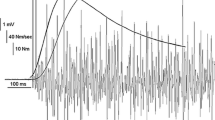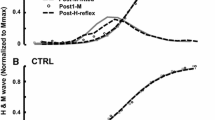Abstract
Activity-related knee joint dysfunction is more prevalent in females than males. One explanation for the discrepancy is differences in movement patterns between the sexes. However, the underlying mechanisms responsible for these differences remain unidentified. This study tested spinal motor control mechanisms influencing motor neuron pool output and subsequent muscle activation in 17 males and 17 females. The following variables were assessed at the soleus: the gain of the unconditioned H-reflex, gain of both intrinsic pre-synaptic inhibition (IPI) and extrinsic pre-synaptic inhibition (EPI), the level of recurrent inhibition (RI), the level of supraspinal drive determined by the ratio of the V max:M max (V-wave), electromechanical delay (EMD) and the rate of force development (RFD). The Wilks Lambda multivariate test of overall differences among groups was significant (p = 0.031). Univariate between-subjects tests revealed males had greater RI (p = 0.042). However, the sexes did not differ on any of the other variables tested. In conclusion, the sexes differ on modulation of spinal motor control. Specifically, RI, a post-synaptic regulator of force output, was greater in males.


Similar content being viewed by others
References
Aagaard P (2003) Training-induced changes in neural function. Exerc Sport Sci Rev 31:61–67
Aagaard P, Simonsen EB, Andersen JL, Magnusson P, Dyhre-Poulsen P (2002) Neural adaptation to resistance training: changes in evoked V-wave and H-reflex responses. J Appl Physiol 92:2309–2318
Agel J, Arendt EA, Bershadsky B (2005) Anterior cruciate ligament injury in national collegiate athletic association basketball and soccer: a 13-year review. Am J Sports Med 33:524–530
Behm DG, Sale DG (1994) Voluntary and evoked muscle contractile characteristics in active men and women. Can J Appl Physiol 19:253–265
Bell DG, Jacobs I (1986) Electro-mechanical response times and rate of force development in males and females. Med Sci Sports Exerc 18:31–36
Boling M, Padua D, Marshall S, Guskiewicz K, Pyne S, Beutler A (2010) Gender differences in the incidence and prevalence of patellofemoral pain syndrome. Scand J Med Sci Sports 20:725–730
Capaday C (1997) Neurophysiological methods for studies of the motor system in freely moving human subjects. J Neurosci Methods 74:201–218
Christie A, Lester S, LaPierre D, Gabriel DA (2004) Reliability of a new measure of H-reflex excitability. Clin Neurophysiol 115:116–123
Del Balso C, Cafarelli E (2007) Adaptations in the activation of human skeletal muscle induced by short-term isometric resistance training. J Appl Physiol 103:402–411
Earles DR, Dierking JT, Robertson CT, Koceja DM (2002) Pre- and post-synaptic control of motoneuron excitability in athletes. Med Sci Sports Exerc 34:1766–1772
Ellaway PH (1978) Cumulative sum technique and its application to the analysis of peristimulus time histograms. Electroencephalogr Clin Neurophysiol 45:302–304
Griffin LY, Albohm MJ, Arendt EA, Bahr R, Beynnon BD, Demaio M, Dick RW, Engebretsen L, Garrett WE Jr, Hannafin JA, Hewett TE, Huston LJ, Ireland ML, Johnson RJ, Lephart S, Mandelbaum BR, Mann BJ, Marks PH, Marshall SW, Myklebust G, Noyes FR, Powers C, Shields C Jr, Shultz SJ, Silvers H, Slauterbeck J, Taylor DC, Teitz CC, Wojtys EM, Yu B (2006) Understanding and preventing noncontact anterior cruciate ligament injuries: a review of the Hunt Valley II meeting, January 2005. Am J Sports Med 34:1512–1532
Hakkinen K (1993) Neuromuscular fatigue and recovery in male and female athletes during heavy resistance exercise. Int J Sports Med 14:53–59
Hoffman MA (2010) H-reflex profile differences between the sexes. J Ath Train 45:523–524
Hoffman M, Schrader J, Applegate T, Koceja D (1998) Unilateral postural control of the functionally dominant and nondominant extremities of healthy subjects. J Athl Train 33:319–322
Hultborn H, Pierrot-Deseilligny E (1979) Changes in recurrent inhibition during voluntary soleus contractions in man studied by an H-reflex technique. J Physiol 297:229–251
Kipp K, Johnson ST, Doeringer JR, Hoffman MA (2011) Spinal reflex excitability and homosynaptic depression after a bout of whole-body vibration. Muscle Nerve 43:259–262
Knikou M (2008) The H-reflex as a probe: pathways and pitfalls. J Neurosci Methods 171:1–12
Komi PV, Karlsson J (1978) Skeletal muscle fibre types, enzyme activities and physical performance in young males and females. Acta Physiol Scand 103:210–218
Mattei B, Schmied A, Mazzocchio R, Decchi B, Rossi A, Vedel J (2003) Pharmacologically induced enhancement of recurrent inhibition in humans: effects on motoneurone discharge patterns. J Physiol 548:615–629
Pierrot-Deseilligny E, Morin C, Katz R, Bussel B (1977) Influence of voluntary movement and posture on recurrent inhibition in human subjects. Brain Res 124:427–436
Wolpaw J (2001) Motor neurons and spinal control of movement. Wiley, Chichester. http://www.els.net/ (doi:10.1038/npg.els.0000156)
Zehr PE (2002) Considerations for use of the Hoffmann reflex in exercise studies. Eur J Appl Physiol 86:455–468
Acknowledgments
Funding was provided by the National Athletic Trainers’ Association Research and Education Foundation.
Conflict of interest
The authors report no conflict of interest.
Author information
Authors and Affiliations
Corresponding author
Additional information
Communicated by Dick F. Stegeman.
Rights and permissions
About this article
Cite this article
Johnson, S.T., Kipp, K. & Hoffman, M.A. Spinal motor control differences between the sexes. Eur J Appl Physiol 112, 3859–3864 (2012). https://doi.org/10.1007/s00421-012-2363-3
Received:
Accepted:
Published:
Issue Date:
DOI: https://doi.org/10.1007/s00421-012-2363-3




